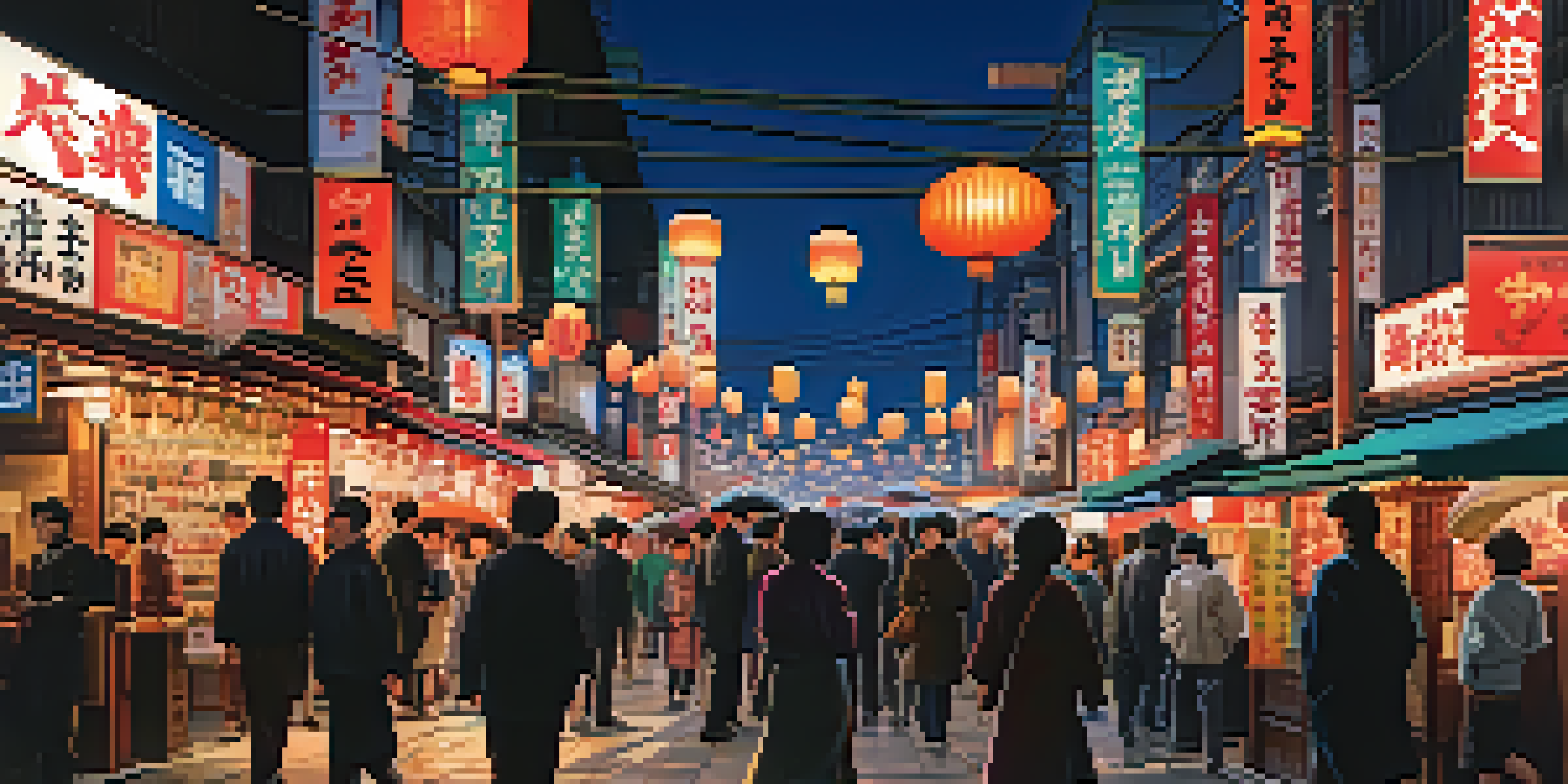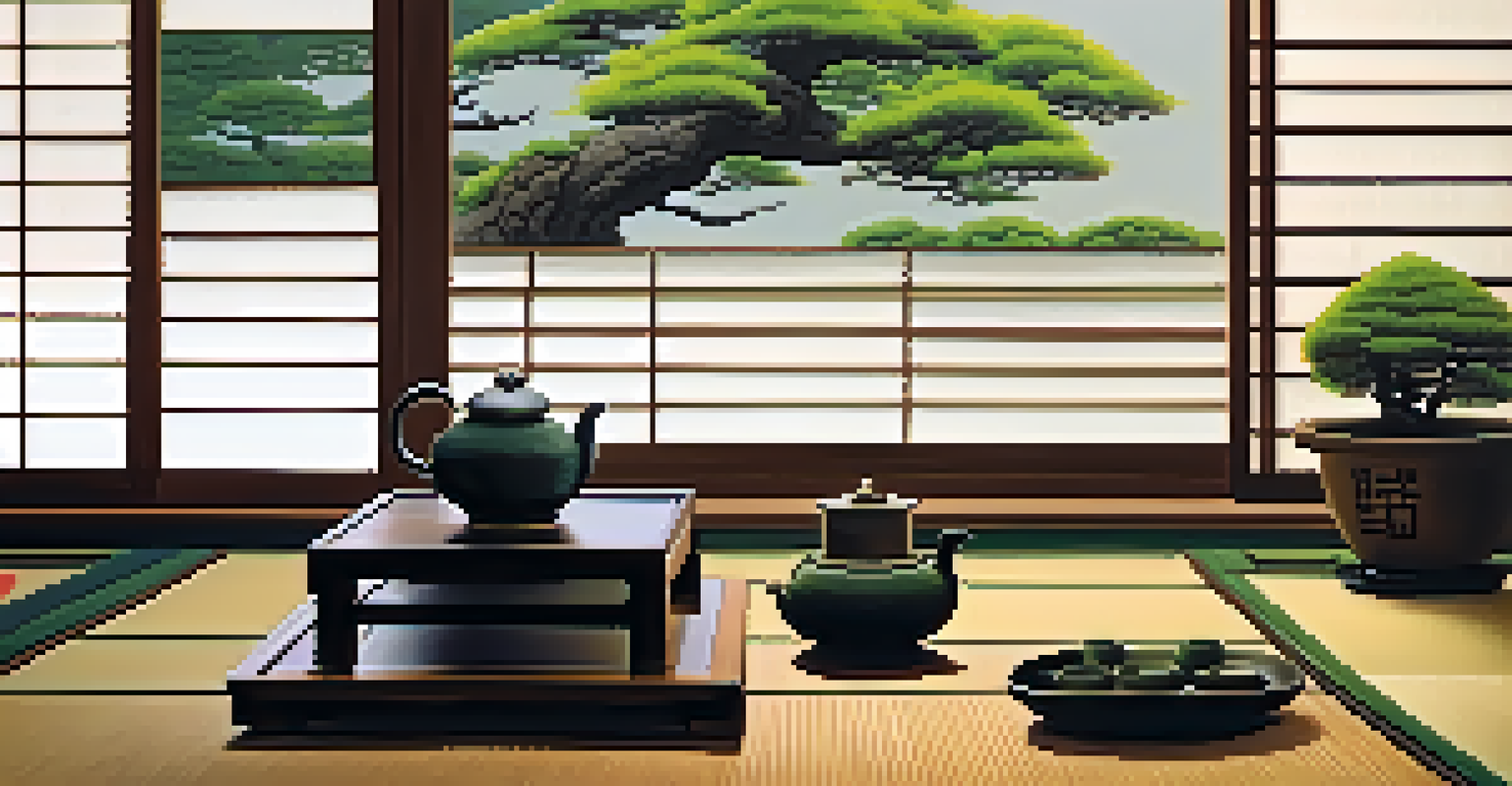Japanese Cinema: Tradition Meets Innovation in Filmmaking

The Roots of Japanese Cinema: A Historical Overview
Japanese cinema has a rich history that dates back to the late 19th century, with the first films produced in the 1890s. Early films were influenced by traditional Japanese art forms, such as Kabuki and Noh theater, which laid the groundwork for storytelling and visual aesthetics in cinema. As the industry developed, Japanese filmmakers began to experiment with narrative techniques, creating a unique blend of cultural expression and cinematic innovation.
The most important thing in filmmaking is the story.
The silent film era, highlighted by directors like Kenji Mizoguchi and Yasujiro Ozu, showcased the emotional depth and visual poetry of Japanese storytelling. Their works often explored themes of family, social status, and the human condition, resonating with audiences both locally and internationally. The transition to sound films in the 1930s further enriched Japanese cinema, allowing for a new dimension of expression through dialogue and sound design.
By the mid-20th century, Japanese cinema gained global recognition, especially with the emergence of iconic directors like Akira Kurosawa. His films, such as 'Seven Samurai,' not only showcased the technical prowess of Japanese filmmakers but also their ability to tell universal stories that transcended cultural barriers. This historical foundation set the stage for the dynamic interplay of tradition and innovation that defines Japanese cinema today.
Cultural Influences: The Heart of Japanese Filmmaking
One of the most striking features of Japanese cinema is its deep-rooted cultural influences. Traditional art forms, literature, and folklore play a significant role in shaping the narratives and visual styles of films. For instance, the concept of 'mono no aware,' which translates to 'the beauty of transient things,' is often reflected in the storytelling, inviting audiences to appreciate the fleeting nature of life.

Additionally, Japanese cinema draws from the aesthetic principles of Zen Buddhism, emphasizing simplicity, harmony, and the beauty of imperfection. This philosophical approach can be seen in the works of directors like Hiroshi Teshigahara, whose films often incorporate elements of nature and minimalism to evoke profound emotional responses. Such cultural influences provide a rich tapestry for filmmakers to explore complex themes.
Historical Foundations of Japanese Cinema
Japanese cinema's evolution from the late 19th century showcases a blend of traditional art forms and innovative storytelling techniques.
Moreover, contemporary filmmakers are increasingly blending these traditional influences with modern storytelling techniques, creating a unique cinematic language. This fusion of old and new allows for fresh perspectives while honoring the cultural heritage that underpins Japanese cinema. By engaging with both historical and modern elements, filmmakers can create works that resonate with diverse audiences.
Iconic Directors: Pioneers of Japanese Cinema
Japanese cinema boasts a remarkable lineup of directors who have significantly shaped the film landscape. Akira Kurosawa is perhaps the most renowned, known for his masterful storytelling and innovative techniques. His films often feature complex characters and moral dilemmas, inviting viewers to ponder the human experience, as seen in classics like 'Rashomon' and 'Ikiru.'
Cinema is a matter of what's in the frame and what's out.
Another influential figure is Hayao Miyazaki, whose animated films have captivated audiences worldwide. Through enchanting storytelling and breathtaking visuals, Miyazaki explores themes of nature, love, and the battle between good and evil. Films like 'Spirited Away' not only showcase his artistic brilliance but also reflect Japanese cultural values, making them relatable to global audiences.
Additionally, contemporary directors like Hiroshi Nakano and Naomi Kawase continue to push boundaries, experimenting with genre and style. Their works often integrate elements of documentary filmmaking, blending reality with fiction to create compelling narratives. These directors exemplify the ongoing evolution of Japanese cinema, illustrating how tradition can coexist with innovation.
Themes and Motifs: Exploring the Japanese Narrative Landscape
Japanese cinema is rich with recurring themes and motifs that reflect societal values and human experiences. Family dynamics, social pressure, and the tension between tradition and modernity often serve as focal points for filmmakers. For instance, Ozu's films frequently delve into family relationships, capturing the nuances of generational conflict and cultural expectations.
Another significant theme is the exploration of the individual versus society, often depicted through characters grappling with identity and purpose. This motif resonates deeply in films like 'Tokyo Story,' where the characters' struggles highlight the broader societal changes in post-war Japan. Such narratives invite viewers to reflect on their own experiences in relation to the world around them.
Cultural Influences on Filmmaking
Deep-rooted cultural elements, such as Zen Buddhism and folklore, significantly shape the narratives and visual styles of Japanese films.
Moreover, the use of symbolism and visual storytelling enhances these themes, making them more impactful. Filmmakers often employ motifs such as nature, seasons, and urban landscapes to convey emotions and ideas. By weaving these elements into their narratives, Japanese filmmakers create a rich tapestry that invites audiences to engage with the underlying messages.
Innovative Techniques: Pushing the Boundaries of Filmmaking
As Japanese cinema evolves, filmmakers are continually pushing the boundaries of traditional filmmaking techniques. From the use of long takes, as seen in Ozu's works, to innovative editing styles employed by contemporary directors, creativity knows no bounds. These techniques not only enhance storytelling but also challenge viewers’ perceptions of narrative structure and pacing.
Additionally, advancements in technology have allowed filmmakers to experiment with new visual effects and animation styles. For instance, the rise of digital cinema has enabled creators to blend live-action with animation seamlessly, creating immersive experiences. This hybrid approach can be seen in films like 'Your Name' and 'Weathering with You,' which combine stunning visuals with poignant storytelling.
Moreover, Japanese filmmakers often incorporate elements from other genres, such as horror and fantasy, to create unique cinematic experiences. This genre-blending approach has resulted in innovative films like 'Ringu' and 'Akira,' which not only entertain but also provoke thought and discussion. Through these innovative techniques, Japanese cinema continues to captivate and inspire audiences around the world.
The Global Impact of Japanese Cinema: A Cultural Exchange
Japanese cinema has made a significant impact on global culture, influencing filmmakers and audiences alike. The unique storytelling and visual styles have inspired a new generation of filmmakers worldwide, leading to a cultural exchange that enriches the film industry. For example, Quentin Tarantino and Martin Scorsese often cite Japanese cinema as a major influence on their works, showcasing the reach of its artistic impact.
Furthermore, international film festivals have played a crucial role in promoting Japanese films, allowing them to reach diverse audiences. Events like the Tokyo International Film Festival and the Cannes Film Festival have showcased groundbreaking works, leading to increased recognition and appreciation of Japanese cinema on the global stage. This exposure has fostered cross-cultural collaborations and exchanges, further bridging the gap between Eastern and Western filmmaking.
Global Impact and Future Prospects
Japanese cinema has influenced filmmakers worldwide and is evolving with new technologies and streaming platforms, ensuring its continued relevance.
As a result, the themes and aesthetics of Japanese cinema resonate with viewers from different cultures, sparking discussions about universal human experiences. The cultural exchange not only enriches the global film landscape but also fosters understanding and appreciation of Japan's rich artistic heritage. This ongoing dialogue highlights the power of cinema as a medium for connecting people across the globe.
The Future of Japanese Cinema: Embracing Change and Growth
Looking ahead, the future of Japanese cinema appears bright, with a new wave of filmmakers eager to explore uncharted territories. Young directors are embracing change, experimenting with unconventional narratives and diverse genres. This willingness to take risks allows for fresh perspectives that continue to engage audiences, both domestically and internationally.
Moreover, the rise of streaming platforms has transformed the way Japanese films are distributed and consumed. With platforms like Netflix and Amazon Prime showcasing Japanese films, audiences around the world can easily access a variety of content. This shift not only broadens the audience base but also encourages filmmakers to create works that resonate with global viewers.

As Japanese cinema navigates this evolving landscape, there remains a strong commitment to preserving its rich cultural heritage. Filmmakers continue to draw inspiration from traditional practices while incorporating modern techniques to create innovative storytelling experiences. This balance of tradition and innovation will undoubtedly shape the future of Japanese cinema, ensuring its continued relevance in the global film industry.